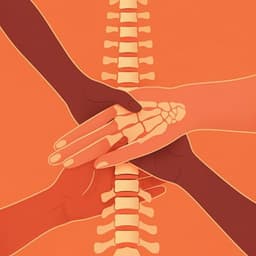
Medicine and Health
Walking naturally after spinal cord injury using a brain–spine interface
H. Lorach, A. Galvez, et al.
Discover how researchers from the NeuroX Institute and other institutions created a groundbreaking brain-spine interface that enables individuals with chronic tetraplegia to stand and walk naturally in community settings. This innovation not only restores movement but also improves neurological recovery, offering hope for those affected by paralysis.
~3 min • Beginner • English
Introduction
The study addresses the problem that spinal cord injury disrupts descending pathways from the brain to lumbosacral spinal circuits that generate walking, resulting in paralysis. Prior work showed that targeted epidural electrical stimulation (EES) of dorsal root entry zones can recruit specific leg motor pools and, with preprogrammed spatiotemporal sequences, restore standing and basic walking. However, previous approaches relied on wearable sensors or compensatory strategies to trigger fixed stimulation sequences, leading to non-natural control and limited adaptability to terrain and volitional demands. The authors hypothesized that creating a direct, wireless digital bridge between brain cortical activity and spinal cord stimulation would enable volitional, graded control over timing and amplitude of lower-limb muscle activity, thereby restoring more natural, adaptive standing and walking after paralysis.
Literature Review
The paper builds on evidence that targeted EES of the lumbosacral cord can re-engage motor pools to restore gait in people with incomplete and complete injuries, supported by computational models and clinical studies. Previous human studies demonstrated restoration of stepping and improvements in motor control with EES, but highlighted limitations in fine-tuning stimulation parameters, synchronizing onset with intention, and achieving graded control. Brain–computer interface research using ECoG and EEG has enabled control of exoskeletons or functional electrical stimulation in paralysis, but non-invasive EEG approaches suffer from poor signal quality and impracticality during mobility. Preclinical studies in primates and rodent models demonstrated brain–spine interfaces that alleviated gait deficits and promoted recovery. Together, this literature suggests that coupling brain intention signals with spinal neuromodulation could overcome timing and amplitude control limitations and promote neural reorganization during rehabilitation.
Methodology
Design and hardware: The authors integrated two fully implanted, wirelessly connected systems to form a brain–spine interface (BSI): (1) cortical ECoG recording implants (WIMAGINE) comprising two epidural 64-channel grids (8×8, 4 mm × 4.5 mm pitch) embedded in skull-conformal titanium cases; and (2) a lumbosacral EES system using an ACTIVA RC implantable pulse generator connected to a 16-electrode Specify 5-6-5 paddle lead targeting dorsal root entry zones. External antennas in a personalized headset provide inductive power (13.56 MHz) and UHF telemetry (402–405 MHz) to stream ECoG signals to a wearable base station and processing unit for real-time decoding, which then issues EES commands with approximately 100 ms end-to-end latency.
Participant and surgical procedures: Within the STIMO-BSI clinical trial (NCT04632290), a 38-year-old male with chronic incomplete cervical (C5/C6) spinal cord injury (10 years post-injury), previously enrolled in STIMO (NCT02936453), received: (a) preoperative CT, MRI, and magnetoencephalography to localize cortical regions linked to attempted lower-limb movements and plan bilateral ECoG implant positions; (b) neurosurgical implantation via bicoronal approach with two circular craniotomies and epidural placement of the ECoG devices; (c) lumbosacral paddle lead localization guided by personalized computational spinal models and intraoperative electrophysiology. The IPG was implanted subcutaneously in the abdomen. The participant was discharged 24 hours after each procedure.
Calibration procedures: Two independent calibration steps were performed.
1) Cortical feature mapping: The participant attempted left/right hip, knee, and ankle movements while seated. ECoG features (spatial, spectral, temporal) linked to intention were identified. Movement-related signals localized to medial electrodes rostral to the central sulcus exhibited somatotopy enabling discrimination among hip, knee, and ankle. Relevant information spanned beta and gamma bands. These features configured the decoders.
2) Spinal stimulation program library: Using the physiological principle that specific anode/cathode configurations and stimulation parameters recruit dorsal root entry zones to modulate defined motor pools, the team configured bilateral programs for hip, knee, and ankle flexion/extension. Parameters included frequency, pulse width, and amplitude ranges; for example, optimal left hip flexors at 300 µs, 40 Hz, 14–16 mA achieved graded control.
Online adaptive decoder: A recursive, exponentially weighted Aksenova/Markov-switching multilinear algorithm linked ECoG features to EES control. It comprised: (a) a gating model estimating probability of intention for specific joints; (b) a multilinear model predicting movement amplitude/direction. A hidden Markov model stabilized predictions. Outputs drove an analogue controller that proportionally modulated joint-specific EES amplitudes, updated every 300 ms.
Initial performance characterization: Within the first post-implant session, the participant controlled bilateral hip flexion of a virtual avatar. Within <2 minutes supine, he generated proportional hip torque with 97% accuracy. The decoder was expanded to seven states (rest plus bilateral hip, knee, ankle control), achieving 74 ± 7% accuracy with 1.1 ± 0.15 s latency.
Walking calibration and testing: Stimulation programs were selected to target weight acceptance, propulsion, and swing functions. The BSI was calibrated to control relative amplitudes of weight-acceptance and swing programs. Tests included voluntary foot lifts while standing, walking with crutches overground and on treadmill, switching BSI on/off, and tasks on complex terrains (ramps, stairs, obstacles). Kinematics and EMG were recorded; PCA compared gait features during BSI vs sensor-triggered closed-loop EES.
Stability assessments: Longitudinal ECoG signal quality, decoder feature stability, decoding accuracy during walking, and stimulation amplitude ranges/thresholds were monitored over ~1 year. Additional tests checked decoder performance after multi-month intervals without recalibration.
Neurorehabilitation protocol: After prior three years of home EES use with plateaued recovery, the participant underwent 40 BSI-supported neurorehabilitation sessions (walking with BSI, single-joint training with BSI, balance with BSI, standard physiotherapy), focusing on hip flexor control. Clinical outcomes without stimulation were assessed pre-/post-interventions (lower-limb motor and sensory scores, WISCI II, 6-minute walk, weight-bearing capacity, Timed Up and Go, Berg Balance Scale, observational gait analysis).
Home integration: A walker-integrated case embedded the entire BSI system and tactile interface for unsupervised operation (setup <5 minutes). The participant used the system regularly over 7 months; PIADS questionnaire captured perceived benefits.
Key Findings
- Rapid, robust calibration: BSI calibrated within minutes; proportional hip torque control achieved within <2 minutes with 97% accuracy.
- Multidimensional control: Seven-state proportional control (rest plus bilateral hip, knee, ankle) reached 74 ± 7% accuracy; chance level ~14%; decoder latency 1.1 ± 0.15 s.
- Immediate functional gains: With BSI, voluntary hip flexion while standing showed ~5× increase in hip flexor EMG compared to attempts without BSI. During overground walking with crutches, the participant exhibited continuous, intuitive control; when BSI was off, stepping ceased despite cortical intentions; walking resumed immediately when BSI was re-enabled.
- Natural gait: PCA of whole-body kinematics and EMG showed gait features with BSI closer to healthy patterns than sensor-triggered closed-loop EES; participant reported fewer temporal mismatches than with motion-sensor triggering.
- Complex terrain: BSI enabled navigation of steep ramps (task completed ~2× faster than without stimulation), stairs, obstacles, and varied terrains using the same configuration, evidencing robustness across tasks.
- Long-term stability: After an initial ~1-month transient, ECoG spectral power decreased only ~0.03 dB/day on average and then stabilized. Decoding features and performance remained stable for ~1 year; similar decoders performed after a 2-month interval without recalibration. Step-wise right hip flexion detection accuracies remained high across sessions at 1 day (0.92 ± 0.1), 2 months (0.93 ± 0.1), 6 months (0.97 ± 0.1), and 11 months (0.97 ± 0.1).
- Stable stimulation: Optimal amplitude ranges for specific electrode configurations and muscle targets remained stable over one year; thresholds did not drift.
- Neurological recovery without stimulation: After 40 BSI-supported rehab sessions, the participant improved light touch sensory score by 4 points, increased lower-limb motor scores, and WISCI II improved from 6 (pre-STIMO) to 16 (post-STIMO-BSI). Clinical measures without stimulation (6-minute walk distance, weight-bearing capacity, Timed Up and Go, Berg Balance Scale, observational gait analysis) all improved significantly (e.g., multiple measures marked with P ≤ 0.002; example gains include substantial percentage improvements in weight-bearing capacity and mobility metrics). The participant could walk 10 m with crutches without assistance or stimulation and reported meaningful quality-of-life gains.
Discussion
Linking cortical intentions directly to modulation of lumbosacral EES overcame critical limitations of prior EES-only approaches by providing precise timing and graded amplitude control of muscle activation. The BSI enabled a natural, intuitive, and adaptive control of standing and walking, including complex real-world terrains, with performance and signal stability sustained over a year and feasible independent home use. The convergence of residual corticospinal pathways and prosthetic stimulation on shared spinal targets likely facilitated activity-dependent plasticity and reorganization, aligning with preclinical and clinical evidence that brain-controlled neuromodulation augments recovery compared to stimulation alone. Although EEG-based non-invasive systems have shown promise, their signal quality and practicality are limited during ambulatory use; a fully implanted ECoG-based system provided robust decoding in mobile conditions. The observed additional neurological improvements following a prior recovery plateau suggest that continuous brain–spinal coupling during rehabilitation can enhance voluntary control even without stimulation, particularly for targeted muscles (hip flexors here). Broader applicability seems plausible given consistent EES physiology across injury severities and the straightforward calibration pipeline, but requires validation in larger, heterogeneous populations.
Conclusion
A fully implanted, wireless brain–spine interface restored natural, volitional control over lower-limb movements to enable standing, walking, and navigation of complex terrains in a person with chronic tetraplegia. The system calibrated rapidly, operated reliably over one year including at home, and supported neurorehabilitation that yielded additional, lasting neurological recovery without stimulation. These results establish a framework for restoring natural motor control after paralysis and suggest that continuous brain–spinal coupling promotes beneficial neuroplasticity. Future work should scale and streamline the technology (miniaturized processing and antennas, faster wireless control of spinal implants, integrated low-power neuromorphic processors with self-calibration), and evaluate efficacy across diverse injury locations and severities, potentially extending to upper-limb restoration.
Limitations
- Single-participant study limits generalizability; injury was severe but partial (incomplete cervical), and applicability across different levels and severities remains uncertain.
- Prior experience with spinal stimulation may have facilitated rapid configuration; impact on naïve users needs assessment.
- Early postoperative transient changes in ECoG spectral content were observed for ~1 month.
- Practical deployment requires further miniaturization and integration (base station, antennas, high-speed spinal implant communications) for broader clinical use.
- Reported clinical gains without stimulation focused mainly on hip flexors; degree of recovery may depend on targeted muscles and lesion severity.
Related Publications
Explore these studies to deepen your understanding of the subject.







